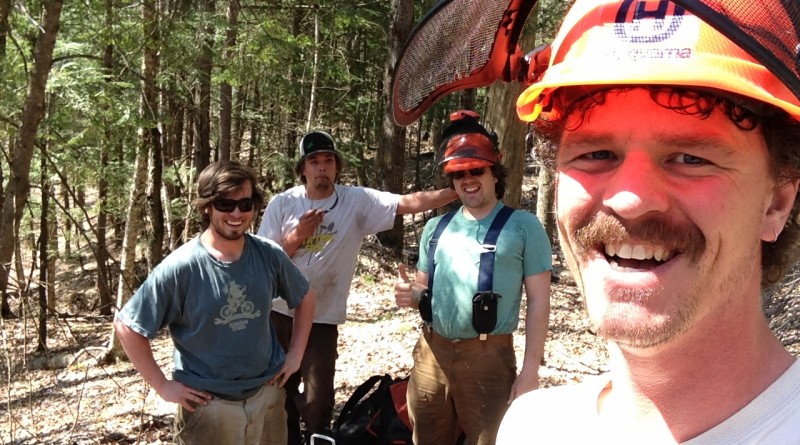Q&A: CJ Scott Trail manager, Kingdom Trails, East Burke
With 12 kilometers of Nordic ski trails and several new fat-bike riding trails open this winter, Kingdom Trails has established a reputation as one of the best outdoor recreation centers in the Northeast. The man behind the sprawling network of trails is CJ Scott, 35, who is in his 12th year at Kingdom Trails as trails manager. Originally the sole staff member, CJ now manages a staff of nine, and when all’s said and done, he can get out and enjoy the trails.
Scott originally moved to Vermont from Maine in 1997 as a student at Lyndon State College in Lyndonville, earning his Bachelor’s of Science in Mountain Recreation Management. Scott started at Kingdom Trails in 2002 as an intern and has stayed since.
Today, his responsibilities include managing a crew of nine guys, prioritizing projects, and slagging and scouting new trails. He works with the trails committee to develop long-term plans, contacts landowners for their input and permission, and helps out at the front desk with any general work: selling memberships and day passes, and doing anything else that comes his way.
Scott spoke with Vermont Sports about his work at Kingdom Trails, how the network in East Burke has developed over the past dozen years, and about the close-knit community of skiers and riders who enjoy the network of trails.
VS: What do you like the most about what you do?
CJ: I love the community aspect of it and how passionate everyone is in seeing Kingdom Trails succeed and grow and provide amazing products to the town and the state of Vermont—everything from bike trails to Nordic trials to fat-bike trails. There’s a great sense of community in what Kingdom Trails has become.
VS: How does the process of designing and maintaining trails change from summer to wintertime use? Can you walk me through the process?
CJ: We’re utilizing the existing trails and corridors so we’re sticking with what we have in the summertime. Any of the doubletrack trails with wider, bigger corridors, we’re able to get snow machines through. We pack all of those [using] snow machines. With singletrack trails, if they’re wide enough to get a snow machine through, we will; otherwise, you snowshoe them—packing down a 10- to 15-inch treadway that you can travel on. You want to try and maintain the snowshoe tracks on the original treadway where you would ride in the summertime. That would even mean making turns, berming it up, maintaining the same flow of the trail that you would have in the summertime and not just walk down the middle of corridor. You have to figure out that line.
VS: What kind of an impact does a network of trails have on the existing forest? How do you as a trail manager minimize it?
CJ: If you build trails correctly, it’ll have a minimal impact on the forest. With that being said, there are times, depending on weather, when you shouldn’t be out riding, regardless of how well the trail is built. Certainly when things are extremely saturated, the water table is pretty high, and everything is soaked, you don’t want to be out riding as that can impact everything from the displacement of soil, water sources, and shorten the lifespan of a trail. As long as they’re built correctly and maintained properly, there’s minimal impact to be had. There is impact, there’s no getting around that. When you first put a trail in, you’re going in and creating a corridor scratch by taking out trees, you try and weave your way through the forest while taking out trees no bigger than your forearm. Once that’s done, you get a good summer’s worth of riding and leaves to fall on it and new grass to grow up, and after a summer’s worth of construction, it looks like it’s been there for all existence.
VS: When you came on as in intern, what was the network of trails like? How has it changed up to today?
CJ: It was fairly similar to what it is today. It wasn’t quite as big, but it was still a pretty well-established network. We didn’t have the ridership that we have now. When I first started, there was no office or front desk. It was just myself at a picnic table underneath a tent with a roll of day passes and a stack of maps, selling passes and giving map information to maybe 100 riders in a weekend. The owner of East Burke Sports, his girlfriend, and me, we were the trail crew. We had no machines, no ATVs, so we were hauling scrap wood into the forest on our backs to build bridges. [Kingdom Trails] certainly had a lot less manpower and organization than it has now, with a parking lot, a full welcome center, and crew of nine guys.
VS: Could you share a little about where you intend to go from here?
CJ: We’ve always got new trails in the works. We’re always looking to try and add one or two new trails per year just to give people something new. Certainly every time people show up for the first ride of the summer, they’re always asking, “What’s the new trail? Where am I going to go?” We’re looking to build and expand throughout the system. I couldn’t give you any projects or exact trails or locations right now, but we’ve got an ongoing five-year plan that is constantly growing and evolving, depending on how we look at the map and see a demand for trails in new areas. We’d like to open up a new corner of the map, or if we see a particular terrain feature that we like and want to incorporate, then we’ll explore that option.


